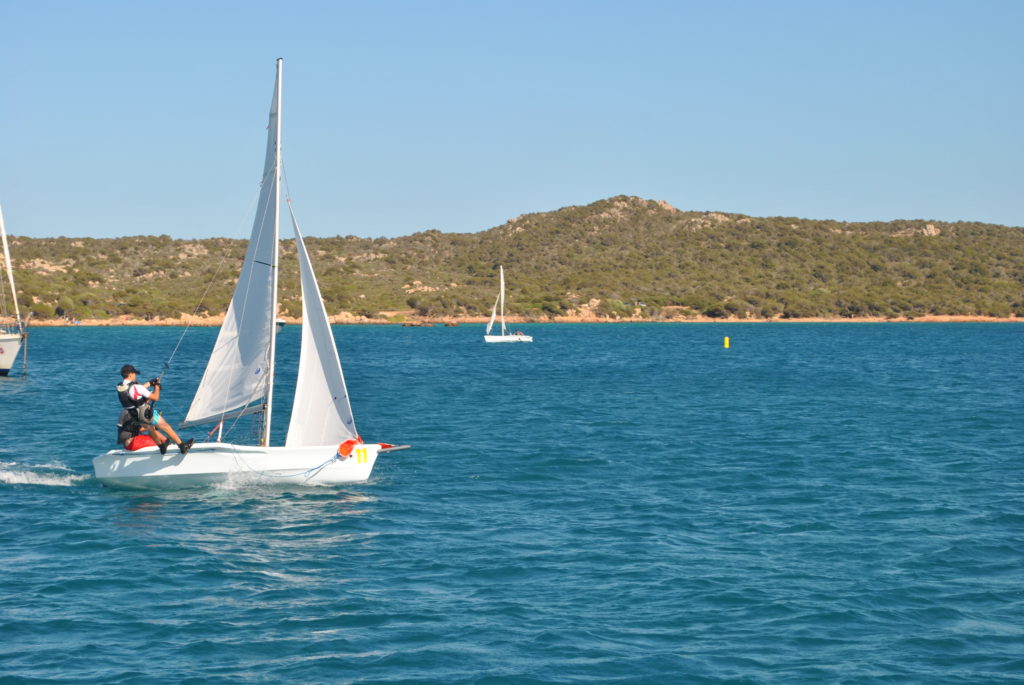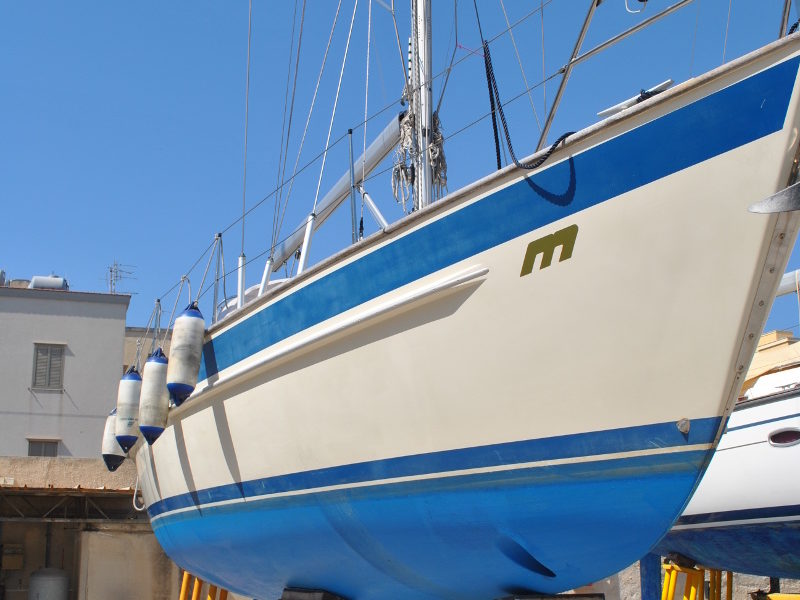
In the claws of the mafia? Or just of a greedy driver
38° 0′ 50.1516” N 12° 31′ 17.5404” E
July 28 to August 2nd
“I do not know about your country. But in Italy, it’s quite normal,” the man insists.
“That’s the price. Just ask any laundry service in all of Italy. They will tell you the same,” he continues. We have arrived in Trapani, on the far western coast of Sicily, some 100 kilometers from Palermo, and we have ended up in the claws of a talented trader, who have seen the possibility of quick gains from a couple of naive sailors, who are obviously from out of town and even on transit. The man, who is a driver for a local laundry, has just presented us with a handwritten laundry bill of 158 €, equivalent to 1200 Danish kroner. 1200 kroner! So much we have never paid for having washed a few t-shirts, bathing shorts and towels. Come on!
Normally we wash our clothes ourselves. Only once earlier we had someone else to wash. That was in Corsica, and the price was 200 kroner.
But in the hectic day before flying back to Denmark, we say yes to an offer from the harbour to have a laundry-driver come and pick up our dirty clothes. On top of that, skipper makes our position even more bad, as he expresses interest, when the laundry driver makes him understand, that he can get for us an exceptional good local wine for a very good price. “If it does not taste you, do not pay at all,” he says.
“Shall we say six bottles? You’ll get them when I’m back with the laundry.
“The six bottles of wine cost 72 Euro. Vivino’s app says, they should cost 58 Euro. But never mind. You win some, and you loose some. But on top of this comes 1200 kroner for washing our bathing-trousers.
We cross our arms and say no. The driver takes a pen and asks us to write, what we will pay. And here begins the bargain: “You do not imagine how much you push me. I’m getting so much in trouble with my friend,” the driver whimpers. We do not know if this friend is the laundry owner or the wine producer. But after ten minutes we end up in 160 Euro instead of the original 230 for laundry and red wine.
He is happy, when he walks. We are happy, when he walks, and now we have learned never to mix laundry with the purchase of red wine and always to ask for the price upfront.
Apart from this, Trapani is a wonderful city. It has culture and style and an outstanding location with water at three of it sides, beautiful churches, relatively well-kept buildings, an overwhelming fish market and many other attractions, that we hardly see, before we have to pack up Ronja and get her lifted to land. Here – in Trapani, Sicily – Ronja is going to stand on a tripod for eight months waiting till we reunite at the end of march 2018.

Buy fish? Trapani has a wild and dynamic fish-market. Primitive sales booths. Shouting and screaming. If you are there, do try and visit the market
Prior to arriving at Trapani we have been on our longest sea trip ever. We headed out from Sardinia’s main town, Gagliari, in a nice wind from behind the mast that blew us over the waters between Sardinia and Sicily for 15 wonderful hours. Then the sun and the moon went down, and they took with them the wind. The engine took over, while the stars turned on the night sky as clear as never before, and in the company of the skipper’s wife’s brother, Jørgen, and his wife, Hanne, we had a wonderful experience with 1200 meters of water under the keel, good company, excellent food produced between the gas cooker’s swing bars – and as a bonus to the early watch-team the morning sunrise and playful dolphins.
After 28 hours of sailing, we reach Sicily’s westerly forepost, the Egadi Islands, in the form of rocky island Marettimo. For hours, we watch Marettimo’s get out of the dusk like a non-welcoming island, and as we take a turn into the island’s only port, it turned out to be just as non-welcoming, as the island had looked. “The harbor is absolutely full,” said a young guy whit no clothes on his upper body, claiming to be a harbour captain. We had called the harbor on VHF Channel 9 without any response, and now we are rejected, backing out to find an anchorage, although anyone can see, that this port is neither full nor half full.
As a couple of us in the evening sail to the harbor in our inflatable boat, there is still only one sailboat in the harbor and plenty of space. We guess, they just do not like strangers on this island. Marettimo is exactly as non-welcoming as it looks. Just pass it. There are better possibilities further east.
We spend the night in an enchanting anchor bay with lots of swimming and snorkeling and wondering, why our engine once again is causing us trouble. Our preferred speed is 2500 rotations. Now we can’t drive it over 1500. Maybe the fuel filter?

Whenever you capture one of the anchor buoys, stick to it. Here we have parked Hanne to make it clear, that this buoy is already taken, while the rest of us are conducting engine-exercises at sea.
Well, who cares. The sky is blue. The wind is favorable. Our moods are just fine.
We head for Trapani, 22 miles further east. Trapani is already scheduled to be this year’s final port. We have an agreement with the local yard about lifting Ronja out of the water, storing her on land and supervising her. Now also we have an agreement to have the engine fixes.

In Trapani a small mouse sneaks onboard Ronja, eats half an apple, shits all over, and hide in a secret place. Skippers wife call Ghostbuster, who turns up with full artillery and makes and end to our secret passenger

Are you off to Sicily? Take plenty of seasickness pills!
39° 12′ 2.3328” N 9° 7′ 33.8772” E
July 19th to July 28th
“Are you off to Sicily tomorrow? Take plenty of seasickness pills,” recommends our Australian neighbours. They have sailed for three years non-stop in the Mediterranean, and one can’t rule out, that they know what they are talking about.
“We have decided to wait until Friday,” says our French neighbour to the other side. He just got his wife and two grandchildren on board, and we had – more or less – planned to sail off to Sicily at the same time. A trip close to 182 nautical miles eastsoutheast, 30 to 40 hours of sailing according to the conditions of the wind.
“We are also waiting till Friday,” says the Italian sailor mooring on the other side of the pier. He thinks that one-and-a-half-meter high waves are somewhat above his level of ambition.
We go to the harbour captain. Let’s hear, what he says: “Wait for tomorrow,” he recommends. The last days of strong breeze are decreasing, but still the waves are high on your way to Sicily.
We do not have anyone to impress with our daring style. We are not even in a hurry. We’ve just – once again – been blown in for four days, and we were so much looking forward to Thursday. But okay. Now it’s going to be Friday instead. We’ll spend another day in Gagliari, the main city of Sardinia.
Gagliari is a large provincial town, about 200,000 inhabitants, and a total fuck up of city-planning, where everything is planned to please private car drivers, and where it may be possible to walk around but impossible to go by bicycle. The city has miles of beach, but to get to this and home again, we have to lift our bikes across the car guard several times and cross the highway traffic. Signs about where to go? Forget about it.

A deserted pizzaria. Sad but symbolic for Gagliari. The town seems worn, it has trouble catching up with modern standards
The city built a pedestrian promenade of several kilometers for pedestrians and cyclists. A very popular place for kissing lovers, and the huge harbour basin is the hunting arena for dolphins, forcing small fish into a corner of the harbour.
This promenade is only a few years old. Nevertheless, the gang-boards are loose and the fence towards the harbour is in the process of rusting.
This is also Gagliari. A city that does not really catch up with time.
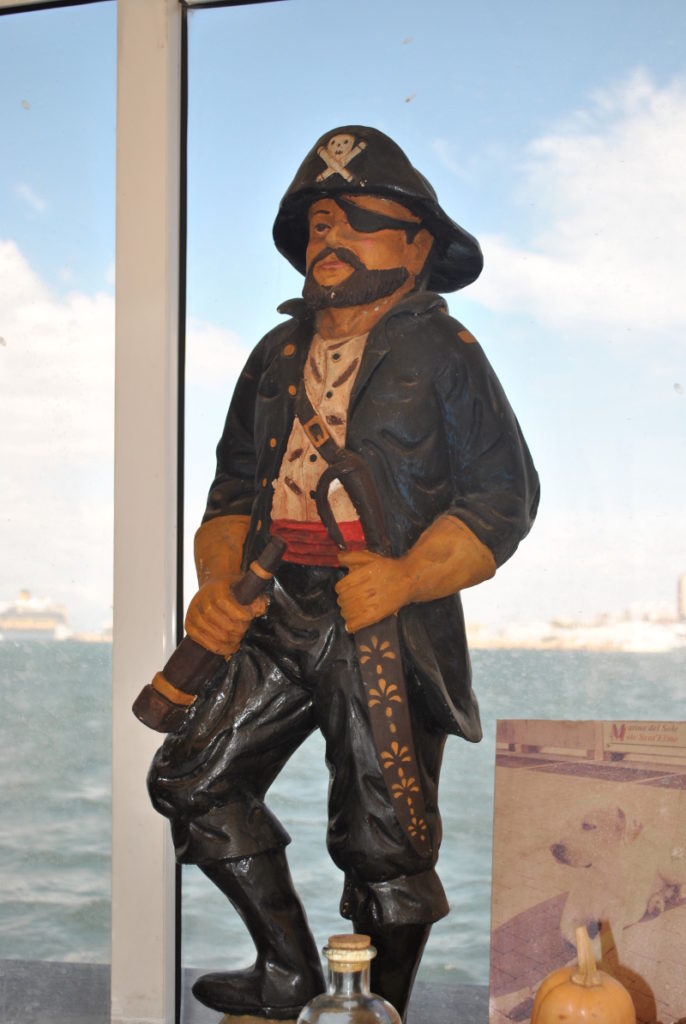
A pirate has his place on the bar-desk of our local bar in Marina de Sole. A primitive but cosy meeting point for sailors in need of wifi and with a lust to exchange good stories
We live in Marina de Sole, one of Gagliari’s many harbours. We went there, because we could see on the web, that many other long time cruising people go to exactly that harbour. Here again we are surrounded by gang-boards, wrecked yachts, a primitive port office in a tent and a toilet, that threatens to topple in the harbour, partly because the toilet bowl is loose and partly because the toilet floor is leaning down towards the harbour.
However, Marina de Sole wins over time. There are many long-distance sailors in that port. There is a fine atmosphere. The captain and he his staff are very helpful. Even the potentially destructive toilet, they take control over. They mold a new floor. The toilet bowl is fixed. My soul what more could you possible want?

In Gagliari Hanne de Linde and Jørgen Folkersen embarks. They are veterans in sailing with Ronja, on her tour around the world. And – as always – the culinary level onboard Ronja rises to astronomic highs with their arrival
Bonus info: Port money can be negotiated. First draft from the port in Gagliari is 50 € per day. We end up paying 33 € per day. Gagliari is said to have Italy’s largest fish market. It’s sumptuous. From swordfish to oysters. Upstairs they have a vegetable-, cheese- and meat-market, which beats most, of what we have seen till now. The market is not easy to find. But do ask for it. It is definitely worth the effort. We found satisfaction in visiting Sardinia’s National Archaeological Museum. You either like that sort of thing or you do not. We do. Best pizza we got at Pizzaria Sardegna. Best dinner we got at Bistro Fork.
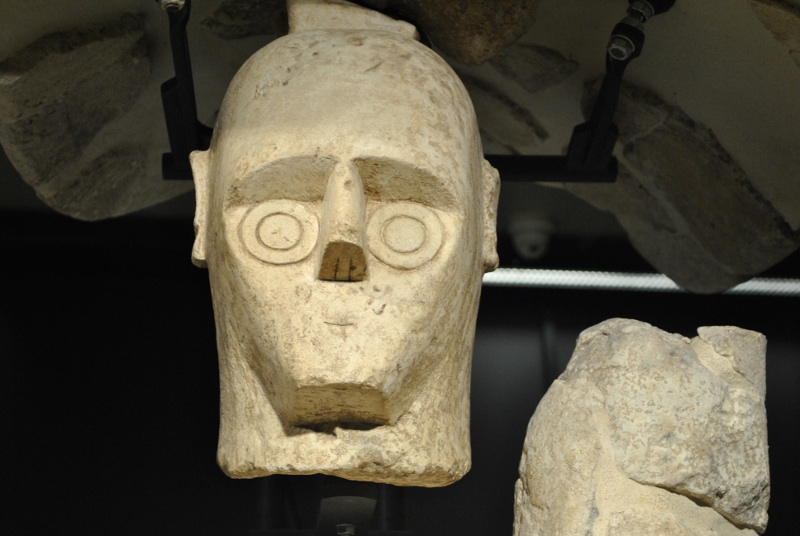
Visitor from outer space? Either this or the sardegneans were just lousy at figuring out the eyes in their art. The text by this sculpture says it is a boxer more than 1000 years before the birth of Christ

Caught in the middle of a town festival
39° 56′ 16.2384” N 9° 42′ 15.714” E
July 13 to July 18th
I do not know what it is with us and town festivals. Ever since we lived in Elsinore 20 years ago and sailed up and down the Swedish coast, we have had the accidental misfortune, that we often go inadvertently to the quay in small towns, just as they are starting their annual town festival – you know, that kind of festival, that goes on until two o’clock in the night, and after that the party goes on in the neighbouring boat, where party-participants continue to the bright morning with more and more snuffling voices.
We know the signals: Colourful swings, carousels, radio cars, flashing lights and from early evening high music from six-seven rides at the same time.
Nevertheless, we go to the dock in Arbatax. It is the only harbour in within miles that has a diesel station, and as we enter the harbour we recognise radio cars with the glimpse of an eye, but it’s too late to retreat. We have another 34 miles to the next port.
Next day we have dinner with two former colleagues from Odense, and then follows two days of strong wind. We are caught in the middle of a harbour festival. Sigh.
Three days of radio cars and dazzling disco rhythms. I desperately try to recall the time when the arrival of a Tivoli to the show area of my childhood town in Denmark gave me palpitations and the hope for beautiful, unknown experiences. But this feeling is lost. I can no longer mobilise enthusiasm for that kind of thing. Diplomatically said.
We had stayed for a couple of days in Santa Maria Navarrese but have now sailed three miles south to fill diesel in our tank and to seek fresh air and new experiences.
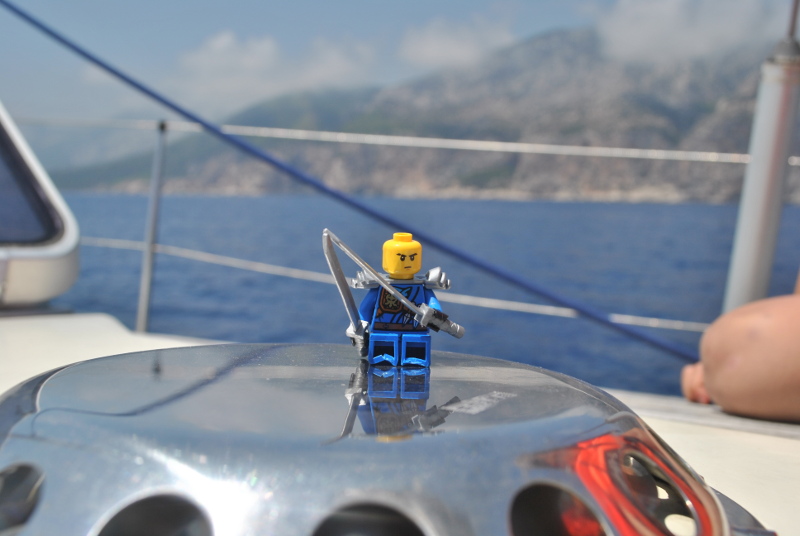
Children onboard change your boat in wonderful ways. Small Lego-warriors guard the deck, and we got a young seaman, who loves to scrub the boat

Many sailors prefer Santa Maria Navarrese to Arbatax. Santa Maria Navarrese is surrounded by high mountains and high piers, superbly protected from winds from all directions, a secure harbour with 16 restaurants and beautiful beaches with parasols and sunbeds. It has everything a vacationing heart can ask for.
But the air stands still. It’s a bit like being beaten in the head with a hammer of heat. Nothing moves. Arbatax is an alternative to this. It is less protected, more open, and for that reason, cool air flows constantly from the sea. You do not bathe from a beach in Arbatax but from cliffs, and the range of restaurants are scarce.
Anyway. Arbatax is an alternative. You should just avoid the second weekend in July, where they have a three-day harbour festival with radio cars, horns, drum dance and on sunday a ceremony where a sainted figure sails at the head of an armada of local boats three times around the huge outer pool of the harbour, while presumable 10,000 spectators are watching from land.
But then again. Who in this world would enter the port of Arbatax in the second weekend in July?

Everywhere in the world, when a tall cliff makes it possible to make stunning jumps into the sea, there will be youth to take up the challenge
Bonus info: If you are in Santa Maria Navarrese and want to eat out, try Mec Puddu’s. It is Sardinian fast food in good quality and at reasonable prices. If you are in Arbatax then try the marina’s restaurant. Pretty good with amazing views. At the local ship chandler you can have a meter of rope for your newly purchased fender with a tailor-made tackle for two just euros. We like that.
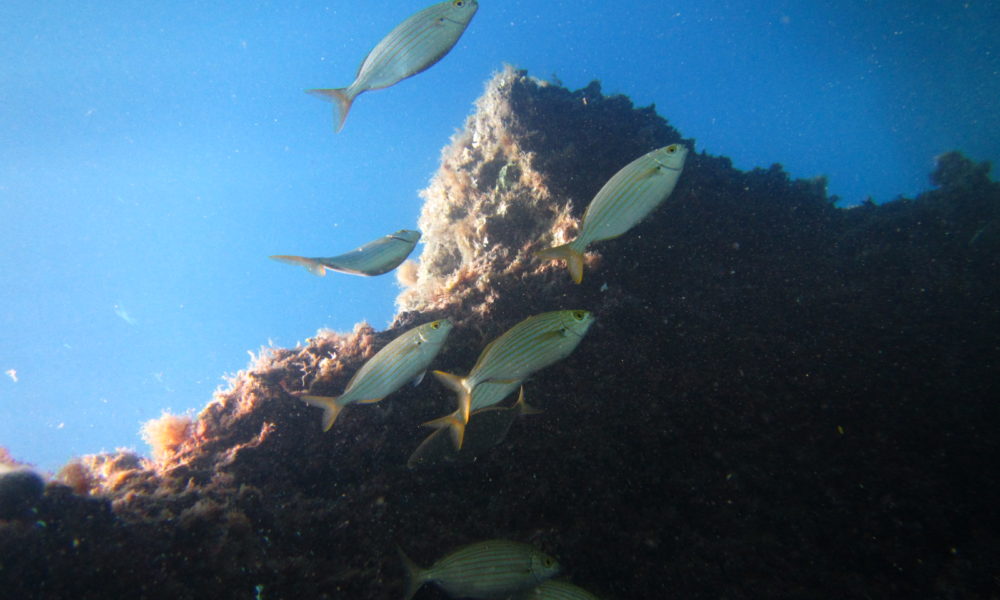
Enchantment Under the Sea
40° 7′ 26.2344” N 9° 40′ 35.346” E
July 12th
Guest blogger: Lasse Folkersen, guest crew member
Ronja-round-the-world is about water and anything related to water. This blog post is about what happens under the sea. As guest-crew on Ronja, along the eastern coast of Sardinia, we had already experienced the majestic cliffs and fantastic beaches offered by the island. But a stay-over day in a harbour with a dive-shop gave the opportunity to expand this into scuba-diving. I have most of my dive-experience from the warm colourful waters of South East Asia and I was unsure what to expect from Mediterranean diving.
I was not disappointed; everything is different, and in some ways less ‘saturated’ – but not at all in a bad way. Of course there are colourful fish here as well, but what I find most attractive is the synergy between the odd-shaped rock formations and the pure white sand. The white beaches of Sardinia in fact continues below the waves, as sandy paths into a maze of underwater tunnels with colorful plants all set in the ever-present Mediterranean azure-blue light from above.

Left: Colourful underwater plants. mail me if you know their exact name. Right: Sandy white beaches. The name of this place was Cala Mariolu.
Bonus info for sailors: If you are sailing in the area north of Arbatax I recommend taking the time for one or more short visits at the beautiful but road-inaccessible beaches. They are not well suited for night-time anchoring, particularly not with strong winds. This is probably the reason why they are not shown in anchor-guide books. But for good reason the beaches are popular destinations for local land-based tourists, using chartered inflatable boats. So many people do this that the beaches are overcrowded in times between arrival and departure times. This, however, is the freedom of having your own boat – and so my best advice is to contact a local tour-agency and ask for their destinations and times; and then go to that place, at some other time than them. At Cala Mariolu, between 1pm and 2pm seemed fairly empty. On arrival, then anchor and swim or row in. That’ll give you pristine, beautiful, secluded and non-crowded beaches.

Well controlled bouyancy in narrow underwater tunnel. Clearly an experienced diver.
Bonus info for scuba divers: I can highly recommend “Diving Cala Mariolu”, which is a tiny diving-operation consisting mainly of three umbrellas, a solar power array, and a few diving guides with a stock of pre-filled air-tanks. All in a very ad-hoc and accessible manner set up directly on the beach. Very straightforward, and actually nicer than some of the larger operations seen elsewhere. I was particularly impressed by dive-instructor Andreas: he managed to be both guide and photographer at the same time, while seemingly also having the overview of the above-water operation. One dive, including all equipment and photos: 60 €. It’s a little colder than South East Asia. Already at 12 m, a short sleeve 3 mm wet suit definitely felt too cold. I also had a booking with Aquatica in Santa Maria Navarrese, but due to a miscommunication I went to a wrong boat from that company, and so I never had the opportunity to see if they were recommendable dive guides.`

Most of all a thumbs up to photographer/instructor/guide Andreas who managed to have everything under control while taking fantastic photos all within a budget of only 60 €

You hardly find better environment for water entertainment than here
40° 51′ 39.9384” N 9° 39′ 23.1012” E
July 9 to July 10th
The weather forecasts of the Mediterranean countries are, as the wind blows, somewhat uncertain. We usually check three weather forecasts: Meteo Consult Marine (which is French), Wind and Sea (which is part of the Italian Lamma weather service) and Windfinder. When two out of the three seem to agree, we believe in it.
However, we should not have done that, when we – with our newly arrived son and granddaughter – sailed out in the seven mile long Golfo di Olbia to round Capo Ceraso and head south to find an adventurous anchorage.
Weatherforecasts predicted 5-6 meters pr second. It turned out to be double up. And even more, as we rounded the “horn”, Capo Ceraso. It felt a little Cape Horn-like, mostly because it was in total contradiction to our desire to give five years old Nellie a great experience of how safe it is to sail in grandma and grandfather’s boat. Clouds pulled up, waves flushed over the forehead of the ship and all the way down to the cockpit. Sometimes we made a speed of less than two knots, because current and wind were working directly against us.
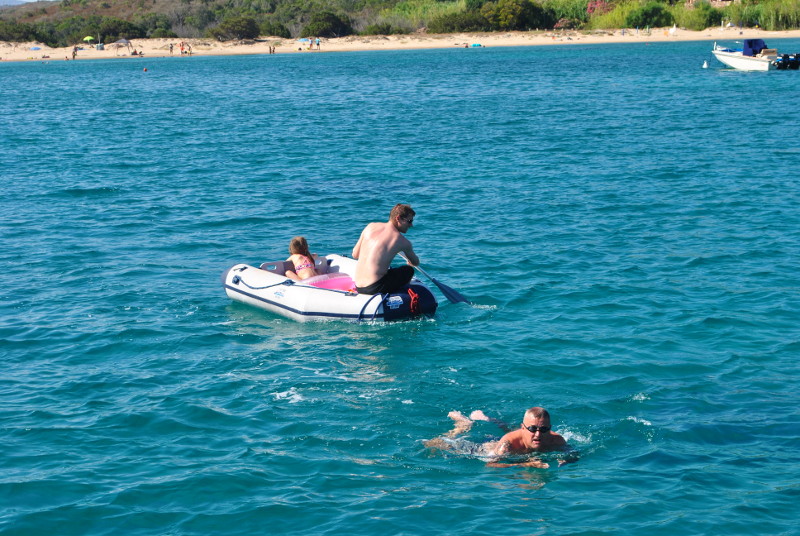
Waterworld. An anchor. A dingy. Googles for swimming. And a beach. What can you possibly demand beyond this?
As long as the adults are not afraid, children are not afraid, and we got an okay trip despite the weatherforecasts, and after a little more than four hours of sailing, we could throw our anchor in the southeastern part of Porto della Taverna, on five meters deep azurean blue water, with good shelter and straight in front of an enchanting beach.
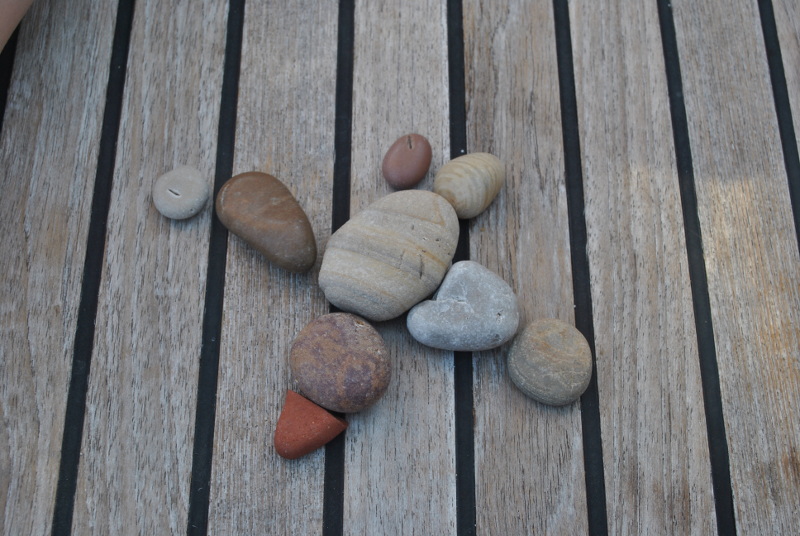

Toys for kids when the tablet was left back in Denmark. Stones in different colours can be used for lots of games, and the bucket will secure a certain coolness
A wonderful anchor bay indeed. Indescribably beautiful and totally suitable for all kinds of playing in the water with our inflatable boat, bathing-ring, swimming wings and snorkeling equipment.
Bonus info: We believe that the bay of Cala Coda Cavallo, three miles further eastsoutheast, may be even better as anchorage, when the wind is blowing from the southeast.
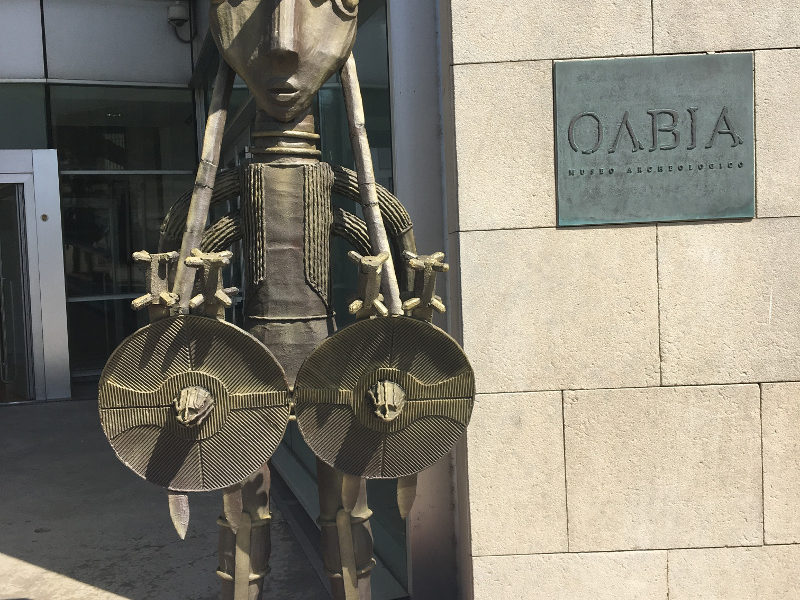
Back to reality: Olbia. A charming mishmash of a city
40° 55′ 21.7992” N 9° 30′ 28.188” E
July 5 to July 9th
After five hours of sailing, we set foot in Circolo Nautic Olbia, a small harbour in the center of Olbia. After 24 hours in the paradise of the super rich, Porto Cervo, we are again 100 percent back in reality. In Olbia we find life and energy, noise and quarrels, ugly houses and beautiful houses. Palms and port industry. A mishmash of a city. Wonderful.
Most guidebooks do not have anything nice to say about Olbia. It has nothing to offer, they claim. We liked the city. It has an active environment around the small city ports, it has a good supermarket, several ship chandlers and an excellent archaeological museum right next to our harbour. A young archeologist guides us into the Nuraghi civilization which laid the foundation for Sardinia from 2000 BC. To 700 BC, when it gradually became absorbed in the culture of the Roman Empire. Simply interesting.

What is this? A kindergarten for buoys growing bigger? An unorthodox signal saying, that here you will find many rocks under sea-level? Buoys by the thousands are marking the route to Olbia.
However, the very best about Olbia is, that the city has an airport. Our son, Lasse, and five years old granddaughter, Nellie, have just announced that their scheduled trip to Geneva has been canceled, and we are eagerly pointing out, that we have an alternative suggestion, while we right now are moored close to an airport with direct exit to five days of unbeatable cruising on board Ronja in the wonderful eastcoast of Sardinia.
Bonusinfo: Try the restaurant Officina de Gusto in Olbia. We found it good value for money. The archaeological museum costs eight euros per person, and for that price you have your very own English speaking guide for an hour. Try it. Some of the small ports of Olbia are private and usually not open to guests. We arrived during the siesta, and when the port people came back to work, they let us stay. You can also lie along the old commercial dock. Maybe it’s free. There is neither electricity nor water.

A beautiful night close to being in company with Bruce Willis and Mick Jagger
41° 8′ 6.072” N 9° 31′ 39.144” E
July 4th to July 5th
Phew! Now we tried that too. We are heading away from the Sardinian port of Porto Cervo after a day in the paradise of the thruly rich – where Bruce Willis and Mick Jagger are said to hang out with the royal and the top of the international jet set. And where the rest of us, are paying the world’s highest harbour fee – even without any certainty, that Bruce Willis and Mick Jagger are or have been nearby.

Offer of the day: Brand new, royal blue Rolls Royce. For sale in the habour of Porto Cervo
Porto Cervo is Costa Smeralda’s navel. The jewel of Sardinia’s emerald coast.
Actually, it is a fantastic story, which began in 1962, when the Arab prince and multi-millionaire Aga Khan bought 55 kilometers of coastline in northeastern Sardinia. He collected a group of other investors, and together they started developing the coast. Their demands to the architects were sky high. All buildings should subordinate to nature, they should – if possible – add to, but never subtract from nature’s own overwhelming, clean beauty.
And that is remarkable.

Even the church – Stella Maris – fit in with the special invented italian architechture
All buildings are held in an almost demonstrative, adventure-like mediterranean style with rounded arches and colors held in tones, that do not exaggerate nature. Throughout it is exclusive. No bumpy high-rise buildings. No individual extensions. No worn out aftermaths from the past.
It is a large area, and the city center is the most discrete city center, we have ever experienced. Here are lots of shops and restaurants, but they appear discreetly, one after the other, on multi-level alleys without significant signage. You never really notice, that you are in a shopping mall.
If you are looking for a baker, a butcher or a grocery store, then forget it. Here we deal in Gucchi bags, Rolex watches, jewelry and branded clothing.
A single supermarket is all, that is meant for those of us with elementary, primitive needs.
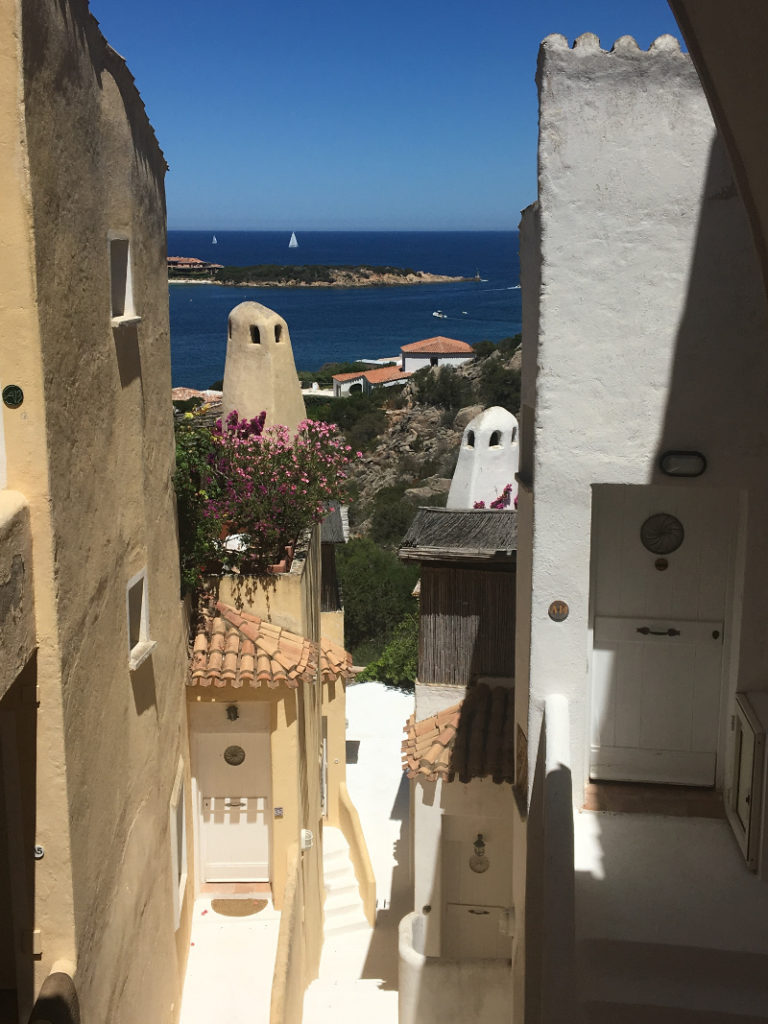
It certainly look beautiful. Very tasteful. Maybe also a bit like Hollywood?
It has been a great vision. Beautifully executed. Sustainable respect for nature. Whauu, that’s excellent. Nevertheless we leave Porto Cervo with the feeling, that it is all artificial and made scenic. Especially we leave Porto Cervo with a disapointment not having met with Bruce Willis, Mich Jagger, Boris Becker and the other celebrities. Maybe they only appear in the area’s sales brochures?
Bonusinfo: Several sailing blogs claim, that the price for one nights stay in Porto Cervo in July is more than 200 € for a boat of 10 meters. That is not correct. We paid 152.50 €, equivalent to 1135 kroner for one night in Porto Cervo. It is more than we have ever paid elsewhere in the world. And we sailors are – as you know – very much concerned about prices in the harbours. Our collegues only travelling by land ocassionaly pay thousands of kroner for a double room in a hotel. But we sailors like it the best, when we can have it for 30-euro-like. Less will be OK.
Phew! Now we tryed that too.
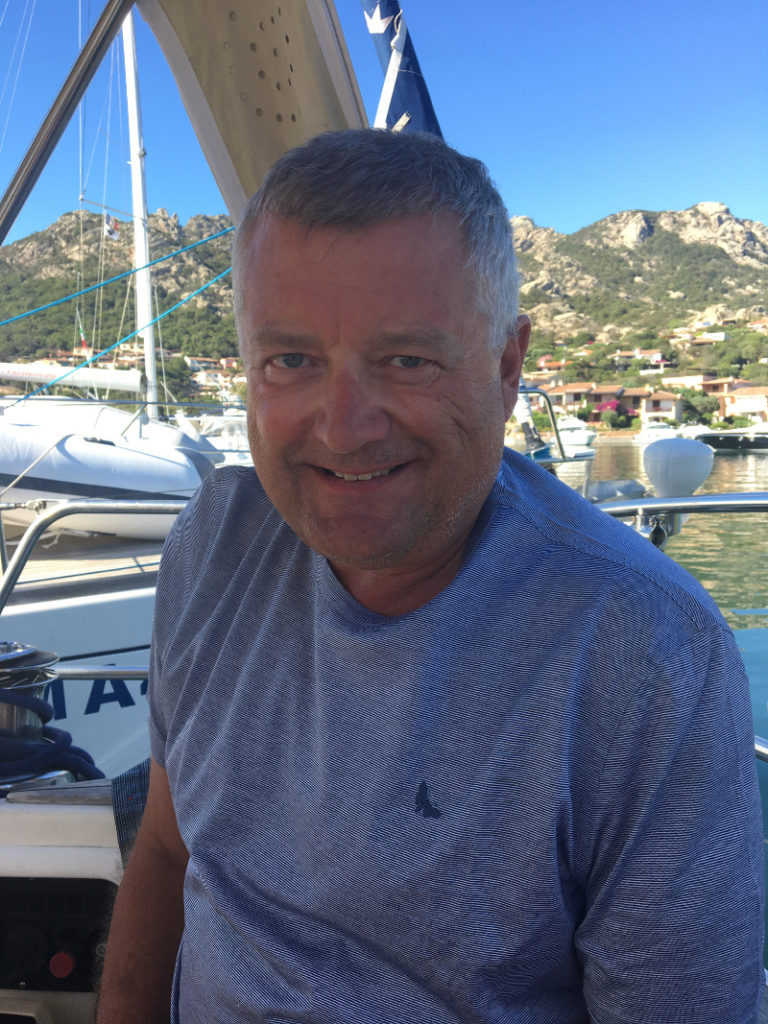
Skipper has his birthday and are woken with singing and a brand new italian t-shirt
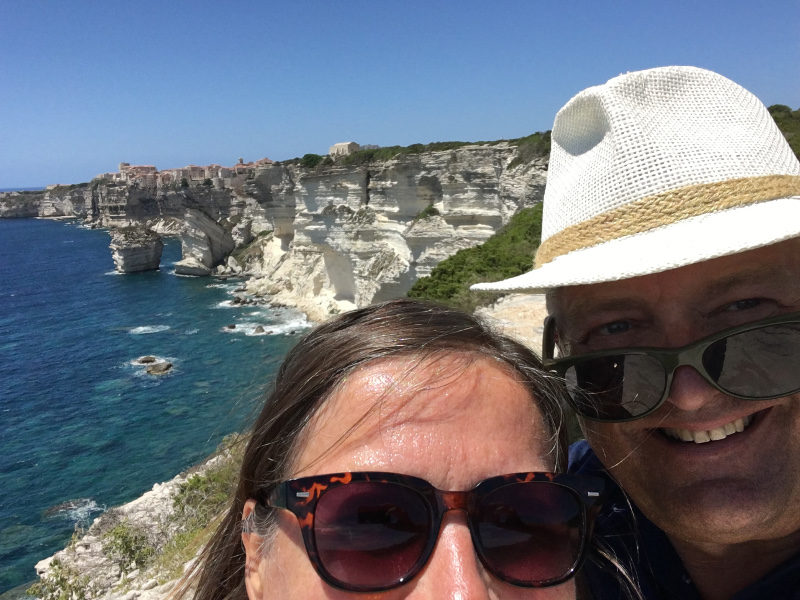
In the wake of Odysseus we sail into the world’s most spectacular natural harbour
only 41° 23′ 17.754” N 9° 9′ 44.3304” E
Sunday 25 June to Friday 30 June
A dream of a sailing day. Again. We hoist the sails, as we leave Propriano, and only take them down again eight hours later, when we arrive in Bonifacio, the southernmost of Corsica’s major cities. A whole day by sail. It doesn’t get much better than that.
Bonifacio is one of the most spectacular and extraordinary harbours, we have ever sailed into. You sail through a small opening in the rocks of the coast, turning immediately to the right and suddenly you find yourself at the beginning of a 1.8 kilometer long calanque or fjord, that runs parallel to the coast but without being visible from the sea, as there are massive rocks between the sea and the harbour.

A miracle of a natural harbour. It’s big, lively, dramatic – something is happening at all times.
It is a natural harbour as if cut by supernatural forces right through the chalk cliffs. It’s hard to describe. It has to be seen. Vertical chalk cliffs on each side of the harbour entrance. Half of the calanque is used as a port, it seems Bonifacio is a favorite springboard for sailors heading from Italy, Sardinia and to the north. And from mainland France through Corsica and to the south.
Historians have identified Bonifacio as the port, that Homer mentions as the port of Laestrygonies in the Odyssey. The port where Odysseus anchored with his his fleet and only barely escaped with enormous losses, when the Laestrygonies set off to drive Odysseus and his people away.
We did not let them drive us away. We stayed for five days. Partly due to weather reports of severe winds from west. But also because we liked the city and its surroundings. There are hiking trails inland and along the sea. Beautiful, healthy and moderately challenging.

Spectacular? Old Bonifacio looks like a village constantly at the risk of falling down into the ocean. It has looked like this for centuries.
Bonifacio is admitted to UNESCO’s conservation list, so it’s not a city you have to yourself. It’s crowded with tourists, there is a light show on the walls of the fortress, and in the early night disco rhythms are pounding throughout the harbour, and may make some sailors grab for their ear plugs.
Every day a new armada of holiday-loving Italian sailors arrive. Their summer vacation has started. They have rented a sailing boat. Now it is time for action. Many of them have a practice where, when they have picked up the mooring lines from the bottom of the harbour, they fix it to their boat, put the engine at full power back, in order to get their mooring lines maximum tight, and then they make the boat firm to the quay.
This is certainly good for the boat in question, but on either side two to three other boats hammer their stern into the quay, because their lines have become too loose, after the newly arrived boat has pulled the common anchor chain on the bottom of the harbour closer to the dock. Damn it! They think it’s their own personal anchor. It’s not. We are all collectively linked to the same key anchor chain!
The skipper’s wife happily enters the cabin and declares that the new neighbors are VERY noble and considerate, and that they have told her, that if she can’t wake up the skipper from his siesta, they will be happy to come over and assist, if we have failed to tighten our own moorings properly. Sigh!
Bonus info: Bonifacio has two supermarkets directly on the quayside. Helpful people at the harbour office. Beware of strong westerly winds. The natural harbour intensify the wind as in a funnel, which can make it difficult to maneuver.
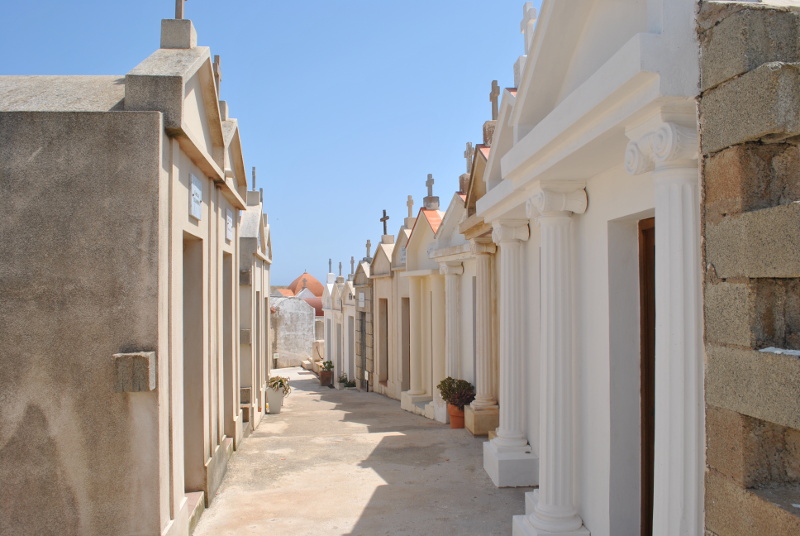
The graveyard at the old Bonifacio on top of the cliff. It gives you an insight into the differences between the southern european catholic culture, and the more pragmatic culture of the northerns, when it comes to the attitude towards the dead.
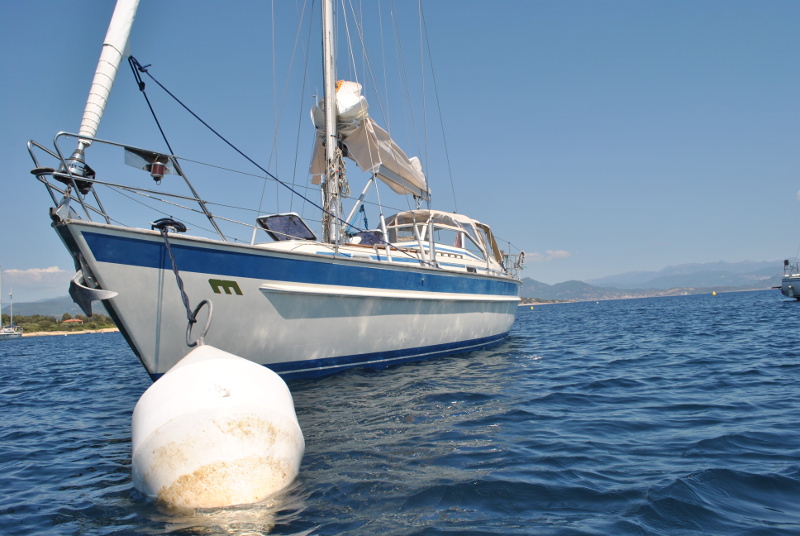
Among pirates and violent offenders
41° 40′ 34.4028” N 8° 54′ 3.4524” E
Wednesday 21th of june to Sunday 25th of June
Fantastic sailing day! We set off from Cargése in the early morning and immediately set sail, even though the wind is weak, and now it’s time for morning coffee. The wind increases during the day, and eight hours later we reach Porto Pollo after an absolutely enchanting day at sea. Dolphins have played alongside the boat. One mountain scenery has replaced the next.
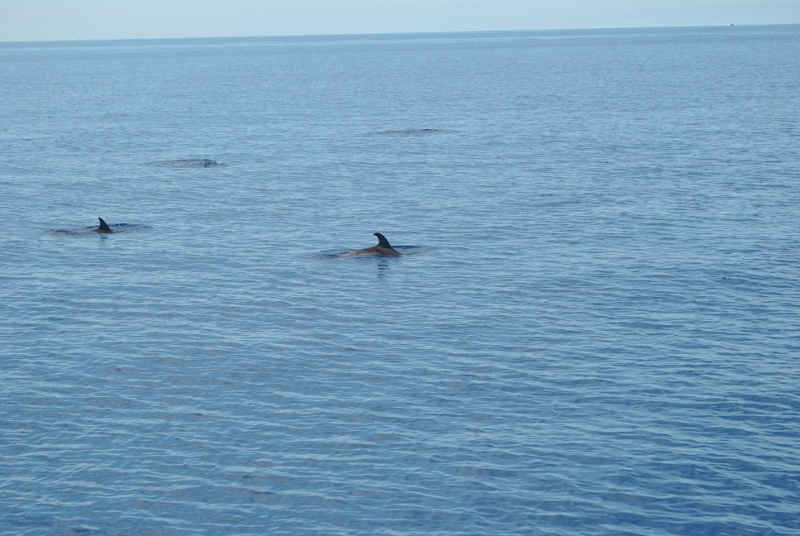
Dancing with Ronja. Five or seven dolphins (or porpoises?) kept dancing and playing around us for a quite a while.
Porto Pollo means “the troubled port”, and it got its name many years ago, when the city was a favourite target for pirates in the area. You don’t see many pirates these days, but the city is obviously preparing for a giant invasion of sailing tourists.
The town itself is small, almost dried up – and honestly quite boring – with its only 100 permanent inhabitants. On the other hand, it is blessed with mile-long beaches, and along these hundreds of buoys are laid out to welcome the invasion of sailors.
We are here outside high season, so less than every tenth buoy is occupied. The price for a buoy outside high season: 20 €.
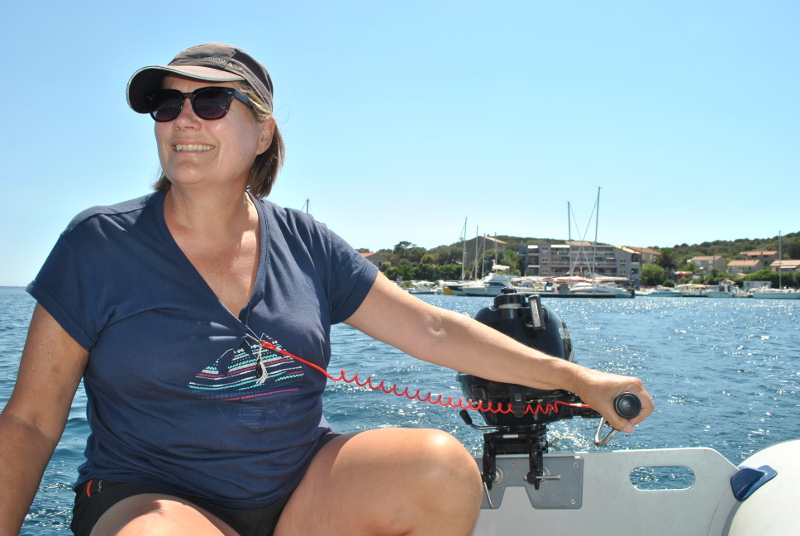
Skippers wife is taking charge. Conquering the steering hand at the inflatable boat. It was bound to happen some day.
After two days of lazy life outside the Porto Pollo beach, we head for Propriano – a bigger city with a real port and 3200 inhabitants.
As always, we prepare ourselves for a new destination, and read in the guidebook, about a dynamic coastal city with a maritime atmosphere and great beach life. In our “bible” during the sailing trip – “Mediterranean France & Corsica Pilot” by Rod Heikell – we find a different and more interesting angle. He writes, that for decades Propriano has had a dubious reputation. In the 1950s, the city was referred to as a city to avoid, where innocent locals were being murdered, and a local fisherman killed the Coast Guard, when he was charged for fishing with dynamite.
Propriano apparently has a large catalogue of violent crimes. As late as april 1990, the liberation movement, FLNC, blew one of the city’s restaurants up.
We ourselves experienced the city as quite peaceful. Good restaurants. Nice beaches. And amiable Frenchmen.
Bonus info: Try eating at Tempi Fa, close to the harbour. It is – according to Tripadvisor – the 39th best of 2,192 restaurants in Corsica – if you rely on review sites like that. During the daytime Tempi Fa offers wine and tapas and in the evening solid Corsican dinner dishes far behind the wine cellar. Tempi Fa is build around a wine bar with exclusively Corsican wines. We had the best red wine so far on our entire time in Corsica. Granite is the name of the wine. Very complex. Full of character. It is an appellation Ajaccio Protégée, but it is produced close to Propriano, which does not have its own appellation. A votre santé!
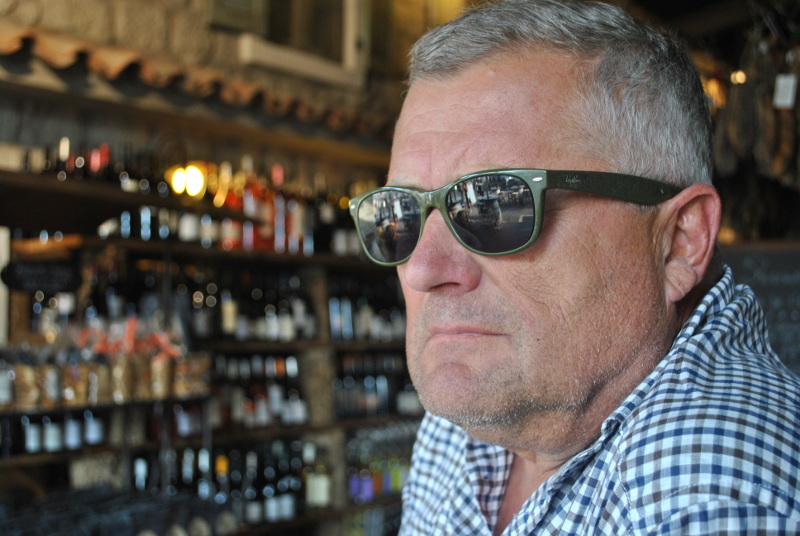
Time for reflexion. A cellar full of only corsican wine. Some of them are thougt-provokingly good.

